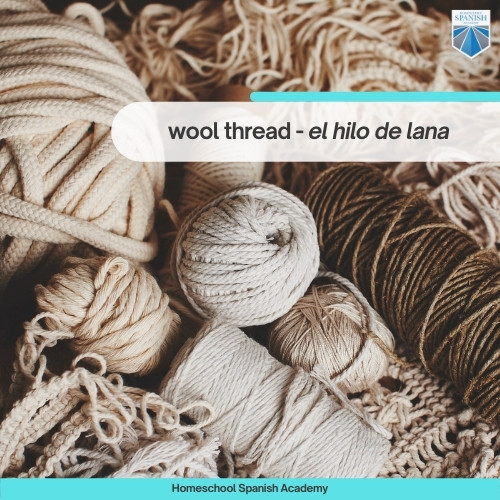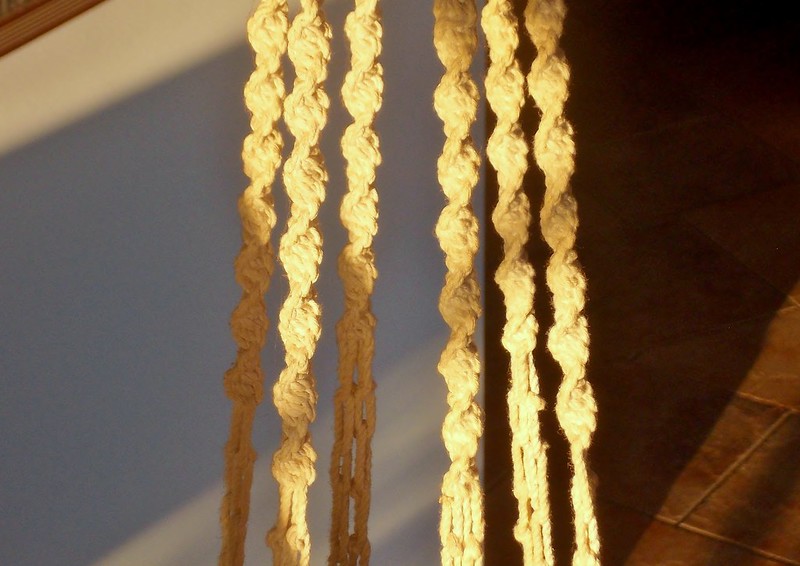
Vocabulary Guide to Macrame in Spanish
El macramé, or macrame in Spanish, is an ancient technique to create fabrics through the use of knots.
Macrame is one of the most popular crafts nowadays because of its simplicity and beautiful patterns. Macramé is a wonderful artistic outlet and you can use it to decorate your home, workspaces, and common areas.
If you are thinking about starting this craft or are already part of the macrame community, then this post is for you!
Macrame is so widely appreciated around the world that sooner or later you will find patterns and lessons of macrame in the Spanish language, so we are to help you get around them.

Join me as I explore this Spanish vocabulary guide to enjoy this creative craft.
All About Macrame in Spanish
There isn’t a correct way to translate macrame in Spanish because it isn’t a Spanish word.
Macramé is a French word that means “knot”—which in turn comes from the Turkish word “makrama,” and it means towel or napkin. Other experts think it comes from the Arab word “migramah,” which means “ornamental border.”
Whether it came from Arabia or Turkey, macrame became widely popular in Europe. During the 17th century, even Queen Mary II from England was teaching this craft to her maids.
Curiously, during the 18th century, macrame was also highly popular among sailors—who liked to spend their time at sea creating pieces to trade or sell back in the mainland. Thanks to them, the knowledge on how to do it was spread around the world.
Macrame, as we know it today, appeared in the 70s in the United States and Europe, where it became a popular hobby and decorative trend. It was during that time that people began to use it to decorate clothes, accessories, textiles, and ornaments.
For a while, it was considered outdated, but thanks to social media today, this craft has another opportunity to show us again how flexible it can be!

Macrame in Spanish Speaking Countries
While the revival of this craft took place in Europe and the United States, it is popular in Spanish-speaking countries.
There are hundreds, if not thousands, of articles on the internet on how to make macrame in Spanish. Much information is available about the most popular designs as well as on how to use it to create dream decorations. Thanks to social media, it is not hard to find inspiration.
I highly recommend the Youtube channel El Arte de Julieta, where you can find videos of macrame like this one.
What I like the most is how easy her explanations can be, making it possible to follow her example. The best part is you can practice your fluency at the same time you learn more about this cool craft!
What Do We Need To Make Macrame in Spanish?
What I like the most about macrame is that you don’t need machinery or tools to create it.
Crochet and knitting require you to have hooks and needles—painting and illustrating require you to have at least pencils or brushes. What about Macrame? You just need a mount, yarn, your hands, and a great amount of creativity.
But, of course, we can expand on what we need so you are prepared to talk about macrame in Spanish whenever you need.
Let’s learn about it then!

Materials (Los materiales)
As I mentioned before, to create decoration or accessories using macrame, you just need a mount, your hands, and some kind of thread to do it.
You can find really fancy threads and mounts, or you can use whatever you can buy in your closest craft store. The important thing here is to create.
Here are some of the most common materials you may need or want when doing macrame in Spanish.
Materials for Macrame in Spanish
| English | Spanish |
| braided cord | el cordón trenzado |
| cord | los cordones |
| cotton thread | el hilo de algodón |
| dowel/ mount | la montura/ el bastidor |
| dye | el tinte/colorante |
| hemp thread | el hilo de cáñamo |
| hooks | los ganchos |
| jute thread | el hilo de yute |
| leather | el cuero |
| nylon thread | el hilo de nylon |
| scissors | las tijeras |
| thread | el hilo |
| wool thread | el hilo de lana |
If you want to learn more about the materials you can use for macrame, check out this video in Spanish. It is easy to understand—besides, fun and energetic. What a great way to learn a new craft!

Most Common Terms (Los términos más comunes)
Now that we know what kind of materials we can use, it is time to get familiar with all the most important and most used macrame terms that you can find in videos, guides, and lessons.
Check out the following vocabulary list on the most common terms of macrame in Spanish:
Terms for Macrame in Spanish
| English | Spanish |
| adjacent | adyacente |
| alternate | alternar |
| anchorage | el anclaje |
| body | el cuerpo |
| bundles | los manojos |
| diagonal | diagonal |
| diameter | el diametro |
| gusset | el escudete |
| hold | sujetar |
| horizontal | horizontal |
| inverted | invertido |
| mounting | el montaje |
| segment | el segmento |
| hook | enganchar |
| vertical | vertical |
Most Common Abbreviations (Las abreviaturas más comunes)
Abbreviations are really popular when doing a craft.
They save time and space, and when you are familiar with them, they are easy to follow. They are also useful when taking notes on a new project or when you get inspired.
Usually, the macrame community uses international terms and abbreviations that are in English, but it is always important to know what they mean in Spanish.
Most Common Abbreviations for Macrame in Spanish
| English | Spanish |
| ASK- alternating square knots | los nudos cuadrados alternados |
| BH – button hole | el ojal |
| DHH – double half hitch | el doble medio enganche |
| LH – larks head knot | el nudo de cabeza de alondra |
| OH – overhand knot | el nudo simple |
| SK – square knot | el nudo cuadrado |
For a better explanation on these abbreviations and terms, please check out this blog post—you will find the explanation is useful and clear.
Patterns (Los patrones)
Patterns in macrame are highly important.
Not only do they give form and meaning to your project but they are also helpful to share how you create your macrame crafts with other people!
Some guides and videos, like this one, can help you understand how to use a certain macrame technique. Sometimes, you will need to understand what pattern you need to use. So, here is a useful vocabulary list of the most common patterns in macrame and their translation in Spanish.

Patterns for Macrame in Spanish
| English | Spanish |
| bar | la barra |
| braids/plaits | el trenzado |
| Chinese macramé | el macramé chino |
| hitch | el enganche |
| interlace | el entrelazado |
| micro-macrame | el micromacramé |
| netting | la red |
| picot | la puntilla |
| sinnet | el sinnet |
| stitch | la puntada |
| vintage pattern | la puntada vintage |
| weave | el tejido |
Knots (Los nudos)
As we learned before, macramé means knot.
So it makes sense that there are some knots you have to learn to be able to make macrame.
There are some classic knots and some newer ones, but all of them serve a purpose and you can use them to create amazing decoration and art.

Here are some of the most common knots for macrame in Spanish:
Knots for Macrame in Spanish
| English | Spanish |
| button knot | el nudo botón |
| alternating half hitches | el nudo festón alternado |
| alternating lark’s head knot | el nudo alondra alternado |
| Chinese knot | el nudo chino |
| cross knot | el nudo en cruz |
| diagonal double half hitch | el nudo festón diagonal |
| double half hitch/ clove hitch knot | el nudo festón/ nudo cordón |
| half square knot | el medio nudo cuadrado/plano |
| horizontal double half hitch | el nudo festón horizontal |
| infinite knot | el nudo infinito |
| lark’s head knot | el nudo alondra |
| spiral knot | el nudo espiral |
| square knot | el nudo cuadrado/plano |
| triangle knot | el nudo triangular |
| vertical double half hitch | el nudo festón vertical |
Check out this video on 5 basic macrame knots for beginners. It is easy to follow and understand.
You can also check out this Domestika video on macrame knots, and even if it is part of a paid course, the information is really complete and useful!
What Can We Create With Macrame?
Now that we know all about macrame in Spanish, the most important terms and abbreviations, the most common materials, and how to name the different knots in Spanish, it is time to learn about the words to explain what we can create with macrame.
If you want to expand your craft circles, learn from international artists or just show off your creations with Spanish-speaking friends and fellow artists, the next vocabulary list can help you!

Creations With Macrame in Spanish
| English | Spanish |
| accessories | los accesorios |
| bags/ handbags | las bolsas/ los bolsos |
| bed heads | los cabezales de cama |
| bracelets | los brazaletes |
| clothes | la ropa |
| decorations | las decoraciones |
| hanging pots | las macetas colgantes |
| lampshades | las pantallas para lámparas |
| pillowcases | las fundas para almohadas |
| rucksacks | las mochilas |
| rugs | las alfombras |
| textiles | los textiles |
| wall hangings | los adornos de pared/ tapices |
Can I Learn Spanish Doing Macrame?
Absolutely!
What I like about crafting the most is that while you do it, you can learn so much more than the craft itself!
I want this guide to be the first step to introduce you to the wonderful world of macrame and Spanish. You can learn the patterns and knots at the same time you practice your fluency. You can read articles in Spanish and put them to practice later when doing the projects there, or you can watch some macrame videos of amazing Spanish-speaking content creators that want to help you be better at macrame.
So, yes! Practicing this craft and researching about it in Spanish will help you become more fluent and, at the same time, it will help you expand your social and creative circles and include Latin American creators in it!
It Is Time to Craft Your Future!
Any new art or technique you want to master depends on how much effort you invest in them. Just like you can invest hours making a macrame piece, you can do the same when you’re studying Spanish. That doesn’t mean it has to be tough—learning a foreign language is also a creative experience!
Learning Spanish will help you improve your cognition and decision-making abilities, a skill that will help you create amazing macrame pieces for decoration or enjoyment. Besides, becoming fluent in Spanish will help you not only to get better and cooler jobs, but also to earn more money.
Imagine being able to sell your creations to an international audience or making an income creating content for social media with a better reach than the usual! It all works together!
So what are you waiting for? Sign up today for a free 1-to-1 class with a certified native Spanish-speaking teacher at Homeschool Spanish Academy and begin to build up your knowledge! Check out our programs, take a peek at our affordable prices, and begin this new adventure with us!
Ready to learn more Spanish vocabulary? Check these out!
- Earth Day Projects for Kids + Spanish Earth Day Vocabulary
- How to Talk About the Temperature in Spanish: Fahrenheit, Celcius, and Descriptions
- Car Parts Spanish Vocabulary List: Learn Using Pictures
- Top 15 New Year’s Resolutions in Spanish
- Talk About Hurricanes And The Weather in Spanish
- Spanish Words with Multiple Meanings in Latin America
- World Mental Health Day: A Vocabulary Guide for Mental Health Workers
- Expressing Appreciation in Spanish on World Teachers’ Day
- An Easy Vocabulary Guide to Describe the Post Office in Spanish - February 10, 2023
- Guatemala’s Biggest, Most Colorful Market: Chichicastenango - December 28, 2022
- 8 Sad Spanish Songs for When Your Heart Is Broken - December 6, 2022





